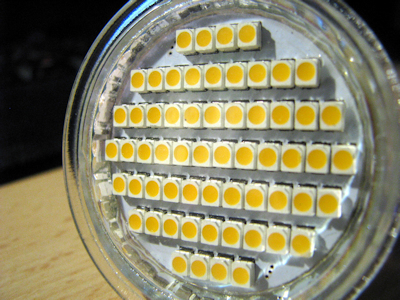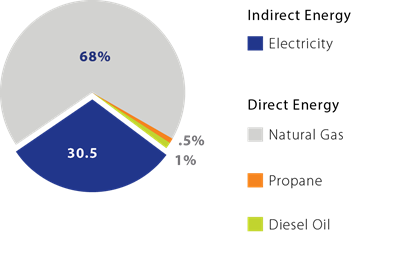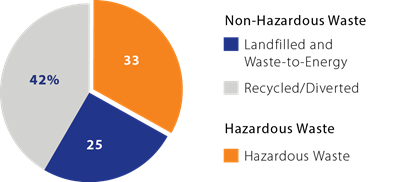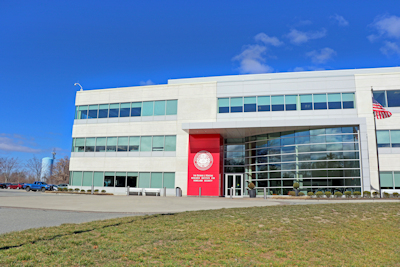
Rogers recognizes the opportunity to positively impact the future by encouraging environmental sustainability practices within our operations and reducing our carbon footprint.
Environmental Compliance
Rogers is committed to carrying out its business in an environmentally responsible manner and to integrating environmental considerations into our decision-making and work activities. We work to understand and responsibly manage existing and emerging risks to the environment associated with, or affected by, our business activities.
We are subject to a variety of federal, state, local and foreign laws, rules and regulations related to the use, storage, handling, discharge or disposal of certain toxic, volatile or otherwise hazardous chemicals, gases and other substances used in manufacturing our products. Rogers operates in full compliance with all applicable environmental regulations in the jurisdictions where our advanced materials and components are produced. This commitment is reflected in our corporate policies, business processes, operational procedures and product designs. We promptly and completely investigate and respond to incidents that result in, or have the potential to cause, environmental harm. The following are some examples of the ways in which we manage our environmental impacts and seek to improve the sustainability of our activities:
- Economizing on our use of non-renewable energy and raw materials
- Minimizing the amount of waste we generate
- Recycling products and raw materials
- Controlling the potential impact of that waste on air and water
- Minimizing any adverse environmental effects associated with our products.
Energy

Just as Rogers’ materials help reduce worldwide energy usage, we also work to decrease the consumption of energy used in our operations. We aim to be as efficient as possible and continually track our energy usage to identify areas for improvement. A few examples of recent actions include:
- Boiler upgrades at one of our China facilities reduced our NOx emissions by two-thirds – from 150 mg/m3 to 50 mg/m3.
- Our Rhode Island manufacturing facility completed a full lighting upgrade to 100% LED fixtures.
- Our Moosup, Connecticut facility converted from #2 and #4 fuel oils to natural gas to reduce greenhouse gas emissions and increase efficiencies.
- Our Belgium operations reduced natural gas usage in 2020 by 15% and electricity by 12%, normalized for production.
| Global Energy Consumption in 2020 | MWh |
|---|---|
| Indirect Energy | 104,634.55 |
| Electricity | 104,634.55 |
| Direct Energy | 238,206.55 |
| Natural gas | 232,427.79 |
| Propane | 2,058.89 |
| Diesel Oil | 3,719.87 |
| Total Energy Consumption | 342,841.10 |
Total Energy Consumption in 2020

Greenhouse Gas Emissions
In 2020, we were pleased to complete our first greenhouse gas (GHG) emissions inventory following the GHG Protocol Corporate Standard, which provides standards and guidance for organizations preparing a GHG emissions inventory. A GHG emissions inventory is the foundation for developing, implementing and monitoring climate change mitigation and reduction initiatives. Participation in an annual GHG emissions inventory demonstrates an important step forward with regards to ESG and business transparency efforts. More information on Rogers’ ESG commitments and targets will be shared in future reports.
By collecting 2019 and 2020 GHG emissions, Rogers has developed an initial baseline to track future GHG emissions progress and potential future expansion of the collection and analysis of the emission sources included in our carbon footprint. Through this analysis, we have outlined relevant sources for direct (Scope 1: natural gas, propane, diesel oil) and indirect (Scope 2: electricity) emissions. In the future, we hope to expand these efforts by including additional sources and Scope 3 value chain emissions.
Our manufacturing facilities are subject to local air emissions permitting and reporting requirements and our comprehensive management systems ensure our continued compliance with permit conditions and regulations. To contextualize our emissions data, we use reporting metrics that account for these factors and monitor relative GHG emissions intensity by normalizing our global footprint according to net revenue. Emissions data for our GHG key performance indicators (KPIs) have been calculated using location-based Scope 2 GHG emissions . Our 2020 GHG KPI is 84.70 tCO2e per $ million USD revenue, based on $802.6 million USD 2020 revenue.
1 The Greenhouse Gas (GHG) Protocol defines location-based scope 2 accounting as a calculation method that utilizes the average emissions intensity of the grid on which energy consumption occurs. A market-based calculation method uses the emissions from electricity that companies have intentionally selected.
| Global GHG Emissions in 2020 | Metric Tons CO2e |
|---|---|
| Direct Scope 1 Emissions | 21,075.06 |
| Indirect Scope 2 Emissions (Location-based) | 46,904.19 |
| Indirect Scope 2 Emissions (Market-based) | 47,673.24 |
| Total Scope 1 + 2 Emissions (Location-based) | 67,929.25 |
| Total Scope 1 + 2 Emissions (Market-based) | 68,748.30 |
Water
Our water management efforts are focused on maximizing water efficiency at our manufacturing facilities to conserve water whenever possible. In 2020, our total water usage was 109.66 million gallons. We continually evaluate process water saving opportunities and track water use at sites to identify areas of improvement. At our Arizona facilities, Rogers continues to take advantage of xeriscaping principles and drip irrigation to minimize water use. We treat industrial wastewater through permitted on-site treatment systems and discharge to publicly owned treatment works. In addition, Rogers utilizes an ion exchange system during the copper etch rinse process to recycle rinse water and reduce the generation of hazardous waste for disposal. This water recycling project is projected to save up to $80,000 per year depending on the rate of production and operations. Currently, we are exploring ways to implement company-wide metrics to better track our water management efforts.
Waste
Driven by our commitment to sustainability, Rogers actively manages and reduces both non-hazardous and hazardous waste generation and works to minimize the amount of waste sent to landfill. We follow the Waste Disposal Hierarchy of focusing on waste reduction starting with prevention, reduction, recycling, recovery and disposal. This hierarchy is followed to reduce Rogers’ environmental impact and promote lean manufacturing across our operations.
Each Rogers facility has a waste management program in place to properly handle, store and dispose of hazardous waste it may generate. In addition, we encourage our supply chain partners to actively participate in energy saving and waste reduction programs. In 2020, we saved $6,000 by recycling intermediate bulk containers through our totes recycling initiative.
We regularly report hazardous waste generation to the US EPA or EPA-authorized state programs. We also track end-of-year waste inventories and provide monthly hazardous waste manifest reports for individual state reporting requirements. Employees who handle or manage hazardous waste receive documented trainings, including introductory and refresher courses. Rogers conducts routine audits of hazardous waste disposal facilities to ensure proper permits are in place and regulatory requirements are met. Special wastes are assessed and handled by authorized and qualified service providers.
| Waste Type | Pounds of Waste Generated in 2020 |
|---|---|
| Non-Hazardous Waste | 21,078,222.53 |
| Recycled/Diverted | 13,062,055.16 |
| Landfilled and Waste-to-Energy | 8,016,167.37 |
| Hazardous Waste | 10,353,682.55 |
| Total Waste | 31,431,905.08 |
Total Waste 2020

Innovation Centers

Innovation is at our very core. We operate four Innovation Centers spanning the globe, with locations in the US, Germany and China. Our vision is to build closer linkages between academic research, industry know-how and technology commercialization. The Centers’ goals are to address global challenges in advanced mobility, telecommunications and additive manufacturing through the development of commercially viable breakthrough innovations and to explore solutions in energy storage.
Our Innovation Center in Burlington, Massachusetts was created in partnership with Northeastern University’s George J. Kostas Research Institute for Homeland Security in 2014. The 4,000 square-foot Innovation Center includes laboratories, conference rooms and office space designed to facilitate communication and collaboration between the on-site Rogers staff members and the Northeastern faculty and students working alongside them. Rogers was drawn to Northeastern specifically because of its commitment to use-inspired research that addresses global challenges—particularly in health, security and sustainability.
